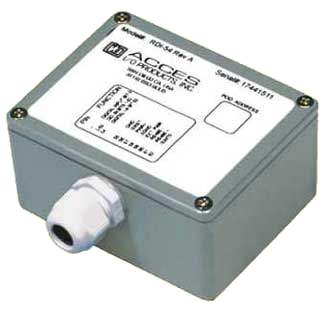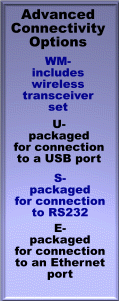RDI-54
REMOTE ACCES 54-Bit Digital Input Pod
Features
- Remote Intelligent Digital Input
- Opto-Isolated RS-485 Serial Interface to Host Computer
- 54 Digital Inputs
- Digital Input Voltages up to 50V
- NEMA4 Enclosure for Harsh Atmospheric or Marine Environments
- Type 8031 Microcontroller with 8K RAM and 8K EEPROM. (32K X 8 optional)
- All Programming in Software, No Switches or Jumpers to Set
- 8-Bit Digital Input Software Counters
- Change-of-State Flag Readable via the Serial Port
- Designed, made, supported, and manufactured in the USA

Model RDI-54 is an intelligent, 54-bit parallel digital-input-to-computer interface unit. It is packaged in a NEMA 4 enclosure for remote installation in harsh environments. There are no switches or jumpers to set to enable half-duplex operation. However, there are jumpers that can be placed to bypass the opto-isolators if you wish. Communication can be at up to 19.2 Kbaud in the isolated mode and up to 28.8 Kbaud in the non-isolated mode. (If the communication cable is short, 56 Kbaud can be realized.)
Digital Inputs may be read in 8-bit bytes at input voltages up to 50 VDC. The input lines are latched into seven 8-bit registers and outputs of the registers are multiplexed to the data bus of the microcontroller. The registers can be scanned either sequentially or at random, one byte at a time. Change-of-state flags can be set on any input bits and can be read via the serial port. This is particularly useful in applications where it is necessary to detect contact closures or openings. This change-of-state detection capability is enabled on a bit-by-bit basis.
A built-in watchdog timer resets the pod if, for some unexpected reason, the microcontroller "hangs up" or the supply voltage drops below 4.75 VDC. Also data collected by the pod are stored in local RAM for later access through the computer's serial port. This feature facilitates a stand-alone mode of operation. For example, a portable or laptop computer that has an RS-485 port can be brought to the pod, connected, and collect the data.
Drivers and Downloads
Full list of available Downloads: Software Packages, Drivers, Manuals, and other documents
Custom Software
ACCES also offers Custom Software Services for our products. Our prices are unbelievably low, often as inexpensive as free! If you need something tweaked to support your needs, or an entire enterprise application developed from scratch, it is definitely worth your time to inquire with us, first.
Further information about available ACCES Software:
- Redistributing Windows Drivers
- A list of ACCES drivers and the files that compose them under different versions of Windows, so you can easily redistribute ACCES cards and drivers.

Serial Communications Interface
- Serial Port: Opto-isolated Matlabs type LTC485 Transmitter/Receiver. Compatible with RS-485 specification. Up to 32 drivers and receivers allowed on line. Pod I/O bus programmable from 00 to FF hex (0-255 decimal). Whatever address is assigned is stored in EEPROM and used as default at next Power-On.
- Input Common Mode Voltage: 300V minimum (opto-isolated). If opto-isolators are by-passed: -7V to +12V.
- Receiver Input Sensitivity: +200 mV, differential input.
- Receiver Input Impedance: 12 kilohm minimum
- Transmitter Output Drive Capability: 60 mA, 100 mA short-circuit current capability.
- Serial Data Rates: Programmable for 1200, 2400, 4800, 9600, 14400, 19200, and 28800 baud. Crystal oscillator provided.
Digital Inputs
- Number: Up to 54
- Sample Rate: Inputs can be scanned, under command, either sequentially or at random.
- Change of State Detection: Change-of-state flags can be set on any enabled input bits and can be read via the serial port.
- Logic Input Low: -0.5V to +0.8V.
- Logic Input High: +2.0V to +50.0V
- Low-level Input Current: 450 microampere maximum.
Environmental
- Operating Temperature Range: 0° to 50°C (Optional -40° to +80°C.). See Temperature De-rating discussion on the REMOTE ACCES Overview page that presents "Specifications Common to all REMOTE ACCES Pods" for temperature de-rating based on power voltage applied.
- Storage Temperature Range: -50° to +120°C.
- Humidity: 5% to 95% non-condensing. Enclosure is designed to meet NEMA4 requirements.
- Size: NEMA4 enclosure 4.53" long by 3.54" wide by 2.17" high.(115mm x 899mm x 551mm)
Power Required
Power for the opto-isolated section can be applied from the computer's +12 VDC power supply via the serial communication cable. Power for the rest of the pod can be supplied by a local power supply.
- Opto-Isolated Section: 7.5 to 25 VDC @ 40 mA. (Note: Due to the small amount of current required, voltage drop in the communication cable will be inconsequential.)
- Local Power: 7.5 to 16 VDC @ 100 mA typical. See box below.
If the local power supply has an output voltage greater than 16VDC, you can install a zener diode in series with the supply voltage. The voltage rating of the zener diode (VZ) should be equal to VI - 16 where VI is the power supply voltage. The voltage rating of the zener diode should be VZ x 0.15 watts. Thus, for example, a 24 VDC power supply would require use of an 8.2V zener diode with a power rating of 8.2 x 0.15 equals approx. 1 watt. Regulatory Compliance
- This product is in full compliance with CE requirements.
| Model | Price (USD) |
|---|---|
| RDI-54 | 325.00 |
| U-RDI-54 | call |
| WM-RDI-54 | call |
| E-RDI-54 | call |
| S-RDI-54 | call |
